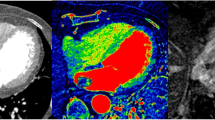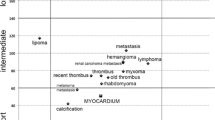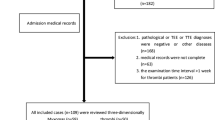Abstract
Although intra-cardiac masses are rare, diagnosis and refined characterization of these masses are important because of the different therapeutic strategies used to treat these lesions. The purpose of this study was to evaluate the diagnostic value of dual-energy cardiac computed tomography (CCT) for differentiating cardiac myxomas from thrombi. Our institutional review board approved this study, and patients provided informed consent. We prospectively enrolled 37 patients who had an intra-cardiac mass on echocardiography or computed tomography (CT). All patients underwent dual-energy CCT. For quantitative analysis, the CT attenuation density and iodine concentration of the intra-cardiac mass were measured on CT images. The Mann–Whitney test was used to evaluate differences in the mean CT attenuation density and the mean iodine concentrations between the cardiac myxoma and thrombus groups. Pathological results or follow-up with echocardiography was used to make the final diagnosis. There were a total of 17 cardiac myxomas and 20 thrombi. On CT, the mean CT numbers were not significantly different between cardiac myxomas and cardiac thrombi (91.7 ± 11.6 HU vs. 85.2 ± 10.9 HU, respectively, P = 0.241), whereas, the mean iodine concentration (mg/ml) was significantly different between cardiac myxomas and cardiac thrombi (3.53 ± 0.72 vs. 1.37 ± 0.31, respectively, P < 0.001). Dual-energy CCT using a quantitative analytic methodology can be used to differentiate between cardiac myxomas and thrombi.




Similar content being viewed by others
Abbreviations
- CCT:
-
Cardiac computed tomography
- CMR:
-
Cardiovascular magnetic resonance
- CT:
-
Computed tomography
- DECT:
-
Dual-energy computed tomography
- GSI:
-
Gemstone spectral imaging
- LA:
-
Left atrium
- LAA:
-
Left atrial appendage
- LV:
-
Left ventricle
- RA:
-
Right atrium
- ROI:
-
Region of interest
- RV:
-
Right ventricle
References
Castillo JG, Silvay G (2010) Characterization and management of cardiac tumors. Semin Cardiothorac Vasc Anesth 14(1):6–20
Araoz PA, Eklund HE, Welch TJ, Breen JF (1999) CT and MR imaging of primary cardiac malignancies. Radiographics 19(6):1421–1434
Tatli S, Lipton MJ (2005) CT for intracardiac thrombi and tumors. Int J Cardiovasc Imaging 21(1):115–131
Doufekias E, Segal AZ, Kizer JR (2008) Cardiogenic and aortogenic brain embolism. J Am Coll Cardiol 51(11):1049–1059
Ferro JM (2003) Cardioembolic stroke: an update. Lancet Neurol 2(3):177–188
Paraskevaidis IA, Michalakeas CA, Papadopoulos CH, Anastasiou-Nana M (2011) Cardiac tumors. ISRN Oncol 2011:208929
Sparrow PJ, Kurian JB, Jones TR, Sivananthan MU (2005) MR imaging of cardiac tumors. Radiographics 25(5):1255–1276
Bogaert J, Dymarkowski S, Taylor AM (2005) Clinical cardiac MRI. Springer, Berlin Heidelberg New York
Kim EY, Choe YH, Sung K, Park SW, Kim JH, Ko YH (2009) Multidetector CT and MR imaging of cardiac tumors. Korean J Radiol 10(2):164–175
Karcaaltincaba M, Aktas A (2011) Dual-energy CT revisited with multidetector CT: review of principles and clinical applications. Diagn Interv Radiol 17(3):181–194
Johnson TR, Krauss B, Sedlmair M, Grasruck M, Bruder H, Morhard D, Fink C, Weckbach S, Lenhard M, Schmidt B, Flohr T, Reiser MF, Becker CR (2007) Material differentiation by dual energy CT: initial experience. Eur Radiol 17(6):1510–1517
Kang MJ, Park CM, Lee CH, Goo JM, Lee HJ (2010) Dual-energy CT: clinical applications in various pulmonary diseases. Radiographics 30(3):685–698
Hur J, Kim YJ, Lee HJ, Nam JE, Ha JW, Heo JH, Chang HJ, Kim HS, Hong YJ, Kim HY, Choe KO, Choi BW (2011) Dual-enhanced cardiac CT for detection of left atrial appendage thrombus in patients with stroke: a prospective comparison study with transesophageal echocardiography. Stroke 42(9):2471–2477
Hur J, Kim YJ, Lee HJ, Nam JE, Hong YJ, Kim HY, Lee JW, Choi BW (2012) Cardioembolic stroke: dual-energy cardiac CT for differentiation of left atrial appendage thrombus and circulatory stasis. Radiology 263(3):688–695
Gomes AS, Lois JF, Child JS, Brown K, Batra P (1987) Cardiac tumors and thrombus: evaluation with MR imaging. AJR Am J Roentgenol 149(5):895–899
Weinsaft JW, Kim HW, Shah DJ, Klem I, Crowley AL, Brosnan R, James OG, Patel MR, Heitner J, Parker M, Velazquez EJ, Steenbergen C, Judd RM, Kim RJ (2008) Detection of left ventricular thrombus by delayed-enhancement cardiovascular magnetic resonance prevalence and markers in patients with systolic dysfunction. J Am Coll Cardiol 52(2):148–157
Weinsaft JW, Kim RJ, Ross M, Krauser D, Manoushagian S, LaBounty TM, Cham MD, Min JK, Healy K, Wang Y, Parker M, Roman MJ, Devereux RB (2009) Contrast-enhanced anatomic imaging as compared to contrast-enhanced tissue characterization for detection of left ventricular thrombus. JACC Cardiovasc Imaging 2(8):969–979
Paydarfar D, Krieger D, Dib N, Blair RH, Pastore JO, Stetz JJ Jr, Symes JF (2001) In vivo magnetic resonance imaging and surgical histopathology of intracardiac masses: distinct features of subacute thrombi. Cardiology 95(1):40–47
Grebenc ML, Rosado de Christenson ML, Burke AP, Green CE, Galvin JR (2000) Primary cardiac and pericardial neoplasms: radiologic-pathologic correlation. Radiographics 20(4):1073–1103; quiz 1110–1071, 1112
Scheffel H, Baumueller S, Stolzmann P, Leschka S, Plass A, Alkadhi H, Schertler T (2009) Atrial myxomas and thrombi: comparison of imaging features on CT. AJR Am J Roentgenol 192(3):639–645
Claussen C, Kohler D, Schartl M, Felix R (1983) Computer tomographic and echocardiographic diagnosis of intracardial space occupying masses. Rofo 138(3):296–301
Taylor AJ, Cerqueira M, Hodgson JM, Mark D, Min J, O’Gara P, Rubin GD, American College of Cardiology Foundation Appropriate Use Criteria Task F, Society of Cardiovascular Computed T, American College of R, American Heart A, American Society of E, American Society of Nuclear C, North American Society for Cardiovascular I, Society for Cardiovascular A, Interventions, Society for Cardiovascular Magnetic R, Kramer CM, Berman D, Brown A, Chaudhry FA, Cury RC, Desai MY, Einstein AJ, Gomes AS, Harrington R, Hoffmann U, Khare R, Lesser J, McGann C, Rosenberg A, Schwartz R, Shelton M, Smetana GW, Smith SC, Jr. (2010) ACCF/SCCT/ACR/AHA/ASE/ASNC/NASCI/SCAI/SCMR 2010 appropriate use criteria for cardiac computed tomography. a report of the American College of Cardiology Foundation Appropriate Use Criteria Task Force, the Society of Cardiovascular Computed Tomography, the American College of Radiology, the American Heart Association, the American Society of Echocardiography, the American Society of Nuclear Cardiology, the North American Society for Cardiovascular Imaging, the Society for Cardiovascular Angiography and Interventions, and the Society for Cardiovascular Magnetic Resonance. J Am Coll Cardiol 56(22):1864–1894
Asci CCT, Group CMRGW, Tsai IC, Choi BW, Chan C, Jinzaki M, Kitagawa K, Yong HS, Yu W, Asian Society of Cardiovascular Imaging Cardiac Computer T, Cardiac Magnetic Resonance Imaging Guideline Working G (2010) ASCI 2010 appropriateness criteria for cardiac computed tomography: a report of the Asian society of cardiovascular imaging cardiac computed tomography and cardiac magnetic resonance imaging guideline working group. Int J Cardiovasc Imaging 26(Suppl 1):1–15
Acknowledgments
This research was supported by Basic Science Research Program through the National Research Foundation of Korea (NRF) funded by the Ministry of Education, Science and Technology (2012-R1A1A1013152).
Conflict of interest
None.
Author information
Authors and Affiliations
Corresponding author
Appendix
Appendix
The fundamental equation for quantification of iodine.
First, the attenuation of x-rays of a single energy, E, through two known materials, m1 and m2 (with densities d1 and d2, respectively), may be computed by:
The calculation of the monochromatic image is a linear operation performed on the material basis images and is normalized to water to ensure that the attenuation of water is consistent with that of the polychromatic images, where water is assumed to be material m1.
where I0 is the incident radiation, I is the transmitted radiation, and μ1(E) and μ2(E) are the x-ray attenuation coefficients at a specific energy level E. This equation describes how the material density images are transformed to a monochromatic image at energy E. d1 and d2 are the material densities in milligrams per milliliter of the material density pair.
-
μ1(E) = Water attenuation coefficient at E.
-
μ2(E) = Iodine attenuation coefficient at E.
Rights and permissions
About this article
Cite this article
Hong, Y.J., Hur, J., Kim, Y.J. et al. Dual-energy cardiac computed tomography for differentiating cardiac myxoma from thrombus. Int J Cardiovasc Imaging 30 (Suppl 2), 121–128 (2014). https://doi.org/10.1007/s10554-014-0490-0
Received:
Accepted:
Published:
Issue Date:
DOI: https://doi.org/10.1007/s10554-014-0490-0




